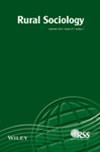COVID - 19大流行后华盛顿基蒂塔斯县的便利移民和社区福祉*
IF 1.9
3区 社会学
Q2 SOCIOLOGY
引用次数: 0
摘要
在过去的几十年里,山间西部地区的舒适移民是一个迅速发展的过程,极大地影响了许多农村社区的福祉。虽然已经通过个别社区案例研究和跨社区比较分析讨论了舒适性迁移的影响,但仍需要继续研究,以继续建立我们对舒适性迁移对个人和社区福祉的影响的理解。在2019冠状病毒病大流行期间,远程和混合工作机会得到了扩大,使越来越多的人能够在非常理想的农村地区,特别是靠近大城市地区的农村地区,从事部分或全职工作。在本文中,我们讨论了基蒂塔斯县,邻近西雅图,华盛顿州,在喀斯喀特山脉东坡的舒适性移民的历史和当前的趋势。根据对三个城镇的主要线人和社区成员进行的80次访谈所分享的观点,我们讨论了便利设施迁移对长期居民和新社区成员的感知生活质量的影响。此外,本研究的设置和范围允许比较具有较大休闲经济的高舒适性农村社区和相邻的低舒适性农村社区。研究结果表明,舒适移民继续发展并影响社区福祉,主要是通过社区文化变化和社会经济和住房不平等。然而,舒适性迁移的影响存在细微的地理和纵向差异。此外,参与者认为,在2019冠状病毒病大流行后的几年里,便利设施迁移模式和影响有所增加。最后,我们讨论了可能有助于支持社区福祉的正在进行的和潜在的举措,以及进一步改进政策和规划的可能性,以公平地提高所有居民的生活质量。本文章由计算机程序翻译,如有差异,请以英文原文为准。
Amenity Migration and Community Wellbeing in Washington's Kittitas County Post‐COVID‐19 Pandemic*
Amenity migration in the Intermountain West is a rapidly evolving process that has greatly impacted wellbeing in many rural communities over the past several decades. While the impacts of amenity migration have been discussed through both individual community case studies and cross‐community comparative analysis, there is an ongoing need for research that continues to build upon our understanding of amenity migration's effects on individual and community wellbeing. Remote and hybrid work opportunities, expanded during the COVID‐19 pandemic, have allowed for an increasing number of people to live part or full‐time in highly desirable rural locations, particularly those proximate to larger urban areas. In this paper, we discuss the historical and current trends of amenity migration in Kittitas County, proximate to Seattle, Washington, on the eastern slope of the Cascade Mountains. Drawing upon perspectives shared in 80 interviews with key informants and community members about community wellbeing in three towns, we discuss the implications of amenity migration for the perceived quality of life of both longer‐term residents and newer community members. Additionally, the setting and scope of this research allows for comparison between high‐amenity rural communities with larger recreation economies, and adjacent less—amenity‐based rural communities. Findings indicate that amenity migration continues to evolve and impact community wellbeing, primarily via community cultural changes and socioeconomic and housing inequality. However, there are nuanced geographical and longitudinal differences in the impacts of amenity migration. Additionally, participants perceived an increase in amenity migration patterns and impacts in the years following the COVID‐19 pandemic. To conclude, we discuss ongoing and potential initiatives that may help support community wellbeing, as well as possibilities for further improvements in policy and planning to equitably increase the quality of life for all residents.
求助全文
通过发布文献求助,成功后即可免费获取论文全文。
去求助
来源期刊

RURAL SOCIOLOGY
SOCIOLOGY-
CiteScore
4.60
自引率
13.00%
发文量
47
期刊介绍:
A forum for cutting-edge research, Rural Sociology explores sociological and interdisciplinary approaches to emerging social issues and new approaches to recurring social issues affecting rural people and places. The journal is particularly interested in advancing sociological theory and welcomes the use of a wide range of social science methodologies. Manuscripts that use a sociological perspective to address the effects of local and global systems on rural people and places, rural community revitalization, rural demographic changes, rural poverty, natural resource allocations, the environment, food and agricultural systems, and related topics from all regions of the world are welcome. Rural Sociology also accepts papers that significantly advance the measurement of key sociological concepts or provide well-documented critical analysis of one or more theories as these measures and analyses are related to rural sociology.
 求助内容:
求助内容: 应助结果提醒方式:
应助结果提醒方式:


